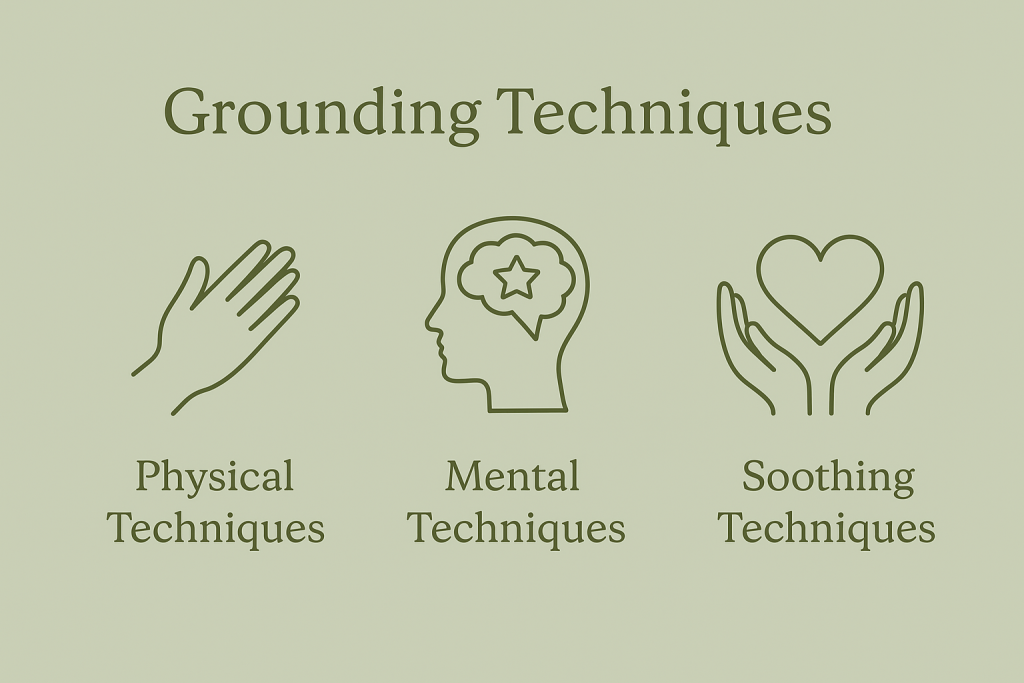Grounding techniques are simple ways to manage anxiety, stress, or other strong emotions by focusing on the present moment. When you’re overwhelmed or triggered by past memories, grounding helps bring your attention back to what is happening right now. These methods can be mental, physical, or soothing, depending on what works best for you. Focusing on the here and now gives you more control over your emotions and can lower their intensity.

There are many grounding techniques used in psychotherapy. Most are easy to do and don’t require any special tools. Some are quick, while others take a little more time. Many don’t even look like “techniques” at all—they may seem like simple activities involving your five senses. Certain techniques may also work better for different emotional states, like grounding for anxiety or grounding for dissociation. I also offer different lists of grounding ideas for specific needs on my blog.
What is a grounding technique?
Grounding is a way to gently disconnect from intense emotional states. Let’s say you start thinking about a painful memory. This is common, especially if you’ve experienced trauma. The brain doesn’t just bring up the memory—it often pulls you into the emotions, and you may find yourself dissociating or spiraling. You might notice your palms sweating, your heart racing, or your breathing getting faster. Once this starts, it can feel very hard to stop.
That’s when grounding can help. It brings your attention back to the present moment and gives your brain something else to focus on. It won’t erase your feelings, but it can stop them from completely taking over. Grounding tools are often part of emotional regulation strategies in trauma-related therapy.
Types of grounding techniques
There are 3 types of grounding techniques:
- physical for senses
- mental for mind
- soothing for self-compassion
For example, the 54321 grounding technique that I describe in another article is considered to be physical, because it involves our 5 senses: see, touch, hear, smell and taste.
In my other articles I provide exercises for all the 3 types. For now, just a few examples so you can understand how it works:
Physical techniques
These involve your five senses. You can try tasting something with a strong flavor like lemon or mint, doing breathing exercises, or feeling the floor under your feet. A warm bath, listening to music, focusing on something in the room, holding an ice cube, walking or running, touching water, or doing a bit of movement like jumping jacks—all these can shift your focus back to your body and the present moment.
Mental techniques
These involve your mind. Try mindfulness or a short meditation. You can also step back and look at your situation objectively. Try imagining a calm, safe place. Name things in a category, like types of fruit or dog breeds. Or try to visualize your emotions—give them a shape or a color.
Soothing techniques
These focus on self-compassion and comfort. Watch a lighthearted show or comedy, do a hobby like drawing or knitting, think about things you love, spend time with your pet, make plans for something fun, or look into self-compassion and how to be gentle with yourself.
Attention! Some grounding techniques involve physical activity. Please make sure they’re safe for you to do. For example, if you have a sore leg, don’t do jumping jacks. Make sure you’re in a safe location too—don’t close your eyes or go inward if you’re outdoors or need to stay aware of your surroundings.
Interesting to know! There’s also something called earthing. This term is often used alongside grounding, but it has a more literal meaning. Earthing means making physical contact with the earth—like walking barefoot on grass, sitting on the ground, or touching natural surfaces. It can be calming for many people, but it’s different from grounding in psychotherapy.
When to use grounding techniques?
Grounding techniques are often used for anxiety, but they’re also helpful for other issues like stress, dissociation, panic attacks, PTSD, and more. Depending on what you’re experiencing, different types of techniques may work better. Grounding can help if you feel detached or out of touch with your surroundings. It’s also useful during moments of self-harm urges, substance cravings, eating disorder behaviors, chronic pain, anger, or after nightmares.
It’s a good idea to decide which technique works best for you and practice it ahead of time. When you’re in the middle of anxiety or emotional overwhelm, it can be hard to remember what to do. Keeping a short list or screenshot of your go-to technique on your phone can be a lifesaver in those moments.
How to make grounding techniques work?
There are a few tips that can help you use grounding techniques more effectively:
- Practice them even when you feel okay, so they’re easier to use during distress
- Repeat them often to remember the steps
- Try to use them as soon as you notice the first signs of distress
- Don’t judge yourself if a technique feels silly or awkward
- Don’t analyze how you feel about what you’re naming or noticing—just stay in the moment
- Rate how you feel before and after (for example, 1 to 10) to track what helps
Frequently Asked Questions
What if grounding methods do not work for me?
Not every grounding method works for every person. If one doesn’t help, try another or even create your own. Think about what usually helps you feel calm or connected. Maybe you feel more grounded when doing something unusual—like solving a math problem or spelling out words. The key idea is: what brings you back to the present moment? Try starting there.
Can grounding techniques stop a panic attack?
Grounding techniques can’t always stop a panic attack completely, but they can help reduce the intensity of symptoms. They work best when used early, as soon as you notice signs like fast breathing or racing thoughts. Grounding helps you stay connected to the present moment, which can give you a sense of control when things feel overwhelming.
How long does it take for grounding to work?
It depends on the person and the situation. Sometimes a technique can help within a few seconds, other times it may take a few minutes of repeated use. If one method isn’t working, try switching to another. What’s important is to keep your focus on the present moment.
What’s the difference between grounding and mindfulness?
Mindfulness is a regular practice where you pay attention to your thoughts, feelings, and sensations in a calm, non-judging way. Grounding is more like a quick tool you use in the moment when you feel anxious, dissociated, or overwhelmed. They’re related, and both help with emotional regulation, but grounding is more urgent and immediate.
Do I need a therapist to use grounding techniques?
No, you can use grounding techniques on your own. They are often taught in therapy, but many people learn and use them without a therapist. However, if your symptoms are strong or you feel stuck, it’s a good idea to work with a mental health professional.
Can grounding be used during a flashback?
Yes. Grounding is one of the most helpful things you can use during a flashback. It helps remind you that the flashback is not happening now, even if it feels real. Touching something, noticing what you see around you, or saying out loud where you are and what day it is can help bring you back.
Are grounding techniques safe for children or teens?
Yes, grounding techniques can be used by people of all ages. For younger children, simple sensory tasks—like holding a favorite object, listening to calming music, or doing gentle movements—can work well. Just make sure the activity is age-appropriate and safe for them to try.
What if I forget what to do when I feel anxious?
That’s completely normal. When anxiety hits, it’s hard to think clearly. That’s why it helps to practice grounding ahead of time, or keep a list or screenshot of your favorite technique saved on your phone. That way, you can quickly remind yourself what to do.
Can I use more than one grounding technique at a time?
Absolutely. Some people combine physical and mental techniques—like walking while naming objects around them. Others move from one method to another until they find what helps. It’s all about what works best for you.
Attention! Grounding techniques are not a replacement for therapy or medication. If you or someone you know is in crisis, contact 911, your doctor, or a licensed mental health professional right away.
